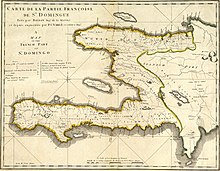Saint-Domingue
From 1697 to 1804, Saint-Domingue was a French colony in what is now Haiti, with the capital Cap-François . The name Saint-Domingue is the French equivalent of the Spanish term Santo Domingo .
history
By 1697, Spain ruled the entire island of Hispaniola , also known as Santo Domingo . In the Peace of Rijswijk , Spain then renounced the western third of the island in favor of France. From now on, the island of Hispaniola was divided into the French Saint-Domingue (now Haiti ) and Santo Domingo (now the Dominican Republic ).
Saint-Domingue, which is now much poorer, had a flourishing economy during the period of French rule. The colonial rulers cut down the jungle to make way for cotton and sugar cane plantations. These goods were successfully exported to Europe together with coffee. At times, Saint-Domingue was France's richest colony. To further increase profits, more and more African slaves were brought to Saint-Domingue, so that by the end of the 18th century 90% of the population were black. At times 40,000 slaves were imported annually. In retrospect, the clearing of the rainforest required for cultivation turned out to be a big mistake and is one of the numerous factors that contribute to the difficult situation of Haiti today. The deforestation caused extreme erosion . Today only 30% of Haiti's agricultural area is usable. Another side effect is that there are no forests as protective walls against floods and mudslides today.
In 1791 the slave revolts began in Saint-Domingue under the leadership of François-Dominique Toussaint L'Ouverture . In the course of the uprisings, there were massacres of the white population, the abolition, reintroduction and renewed abolition of slavery, a French invasion of the island, the expulsion of French troops by the black generals, the civil war between blacks and mulattos and the occupation and later evacuation of the Spanish part of the island. In 1804 Haiti became independent, making it the first independent state in Latin America and the first independent state with a colored population. In addition, the slaves managed one of the most successful slave revolts ever.
Ultimately, however, the euphoric independence of Saint-Domingue was the beginning of their financial and economic downfall. Not much remained of the colony's wealth after independence. The main reason was the compensation payments that Saint-Domingue had to pay to France after its independence. The decline in exports and the increasing subsistence economy of the population also contributed to the decline of the state.
See also
literature
- Erwin Rüsch : The Revolution of Saint Domingue. Hamburg 1930 ( Overseas History , Volume 5)
- Oliver Gliech: The slave revolution of Saint-Domingue / Haiti and its international effects (1789 / 91–1804 / 25). In: Bernd Hausberger , Gerhard Pfeisinger (Ed.): The Caribbean. History and Society 1492–2000. Edition Weltregionen, Vienna 2005, pp. 85–100.
- Oliver Gliech: Saint-Domingue and the French Revolution. The end of white rule in a Caribbean plantation economy . Böhlau Verlag, Cologne / Weimar / Vienna 2011, ISBN 978-3-412-20679-6 .
Web links
- The Louverture Project : Saint-Domingue (English)
Individual evidence
- ^ The Brockhaus in three volumes, Volume 2, 3rd edition (2004), p. 79
- ↑ CLR James The Black Jacobins (Vintage Books: New York, 1963) Pg. 55, citation according to en: History of Haiti
- ^ Economic development in Haiti. In: giz.de (Society for International Cooperation). Retrieved June 12, 2013 .
- ^ Haiti and Dominican Republic: Unequal Neighbors. In: www.zeit.de (Die Zeit). Retrieved June 13, 2013 .
